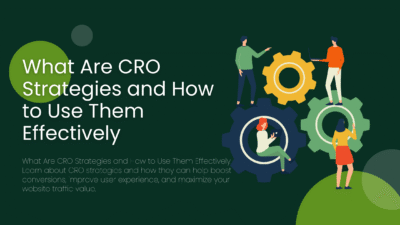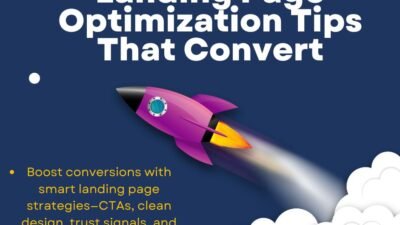Conversion Rate Optimization (CRO) might sound like a buzzword, but it was a game-changer for me in 2019. No other strategy has done so much good for the websites that actually do it on this level. We use Conversion Rate Optimization techniques such as A/B split tests carefully and patiently to make sure everything is crane-handled finely. My personal belief is that this approach, while perhaps slower than buying traffic or search marketing for now (that being said, we have always worked humanely using curiosity laboratories), is what will bring us success over time.
Unique Selling Points of CRO: What Is CRO?
This article will teach you what Conversion Rate Optimization (CRO) is, and how to use its strategies for your webpages. It also explains some of the tools used in making data-driven decisions you can rely on.
Strategies: How to Conduct Conversion Rate Optimization
Tools: What to Use for Conversion Rate Optimization, How to Use Them and Why You Should Use Them
Conclusion
In a word, Conversion Rate Optimization is the process of improving your website or landing page to encourage visitors to complete a specific desired action. This desired action could be anything from purchasing a product, signing up for a newsletter, or downloading an eBook.
To increase the chances of visitors moving from browsers to buyers, or to climb up your conversion ladder in any other way that you like, we are now going to introduce you some core concepts and strategies behind CRO.
Guiding Principles of CRO
Consequently, CRO helps you to subtly steer your existing web traffic in the direction of what you care about. The result: higher return on investment (ROI) without having to spend all that extra cash for ads or traffic acquisition.
When you are aware of the kind of people coming to your site (age, income bracket, married/single status etc.) then it becomes much easier to speak in language which appeals specifically–and perhaps not so specifically–to them. When what you say resonates with them then this group will begin converting. Know that audience!!! Then you have something really good going on here.
Understanding Your Target Audience
This is where every successful CRO strategy starts from. Think about these questions:
- Who is coming to your site?
- What are these people searching for – information, products, services… anything else I can think of?
- What’s stopping them from converting?
- How many weighing scales or directions of this kind can they tolerate in one site session before we lose them to some kind competitor on their way out (the “elevator pitch” problem)?
Surveys + Feedback Forms:
Ask them with tools like Google Forms or Typeform. As well as “What stopped you from buying today?” ask your visitors with questions such as “What prevented you from making a purchase today? a name the problem viewers were most willing to say was that it appeared now they couldn’t anything anyhow because it was only then, when they saw prices on screen and never before, that their reasonable price window reared its head”.
Heatmaps:
Tools like Hotjar or Crazy Egg can show where users click, scroll, or hover most on a page. It gives insights into how they interact with your site.
Optimizing Landing Pages
Avoid steps that distract visitors like a complicated sign-up procedure and take them directly to your product or service page in order to improve conversion rates.
Hiding key information generally leads to low trust far more than just a clunky look does; fancy design can kill trust. Often people are put off because it disrupts their focus when they click through from some other page and get lost in what is essentially new territory that seems both dangerous or disconcerting.
Behavior Analytics
Use platforms like Google Analytics to track user flows, common exit pages, and time spent onsite. Pinpointing where visitors drop off is critical.
Analyzing Website Data
When optimizing for conversions, data is your best friend. By thoroughly analyzing website metrics, you can identify areas of underperformance and develop targeted solutions.
Key Metrics to Monitor:
- Bounce Rate: A high bounce rate could signal that your landing page content is not resonating with visitors.
- Exit Rate: If users consistently exit from specific pages, something on those pages may deter them.
- Conversion Rate: Measure the percentage of visitors who complete your desired action (like filling out a form).
- Click-Through Rate (CTR): Track how well your call-to-action (CTA) buttons and links perform.
Leverage tools like Google Analytics, Adobe Analytics, and Kissmetrics for detailed insights.
Place your CTA buttons in a prominent location, and increase their divisibility. Don’t make it tough for users to find this important link.
Example CTA: “Download Your Free Guide” is more effective than “Submit.”
No Distractions: Take out unnecessary links and elements on your page that may draw readers away from your main goal.
Create landing pages tailored to specific campaigns and track their performance using tools Unbounce, Instapage, or Leadpages.
Improving Website Navigation
If your website navigation is confusing or cluttered, visitors won’t stick around. Easy navigation helps users to find what they want quickly and increases their chances of converting.
Tips for Better Navigation:
- Clean menus with clear categories.
- Include a small search bar on large sites to help users find specific information easily.
- Use internal linking to guide visitors to relevant pages with no effort.
Improving User Experience
User Experience (UX) and CRO go hand-in-hand. No matter how good a deal you are giving away, a poor UX will fend off visitors before they convert.
User Experience Improvements to Make:
- Improve Page Speed: Slow-loading pages frustrate users. Using tools like GTmetrix or Google PageSpeed Insights can help.
- Use Simple, Intuitive Designs: Make sure your layouts are not complicated and pleasant to look at.
- Personalize User Experience: Tools like Dynamic Yield let you make custom experiences based on user behavior and demographic.
Mobile Optimization
With over half of all web traffic coming from mobile devices, you cannot afford not to optimize your site for mobile users if you want to be successful.
Mobile CRO Priorities:
- Make sure your webpages adjust automatically to different screen sizes.
- Simplify navigation on smaller screens.
- Test CTAs: check to see if buttons are easily clickable on touchscreens.
With platforms like BrowserStack end users can test a site across various devices state-of-the-art technology is simpler than ever before.
Case Studies and Examples
Case Study 1
There s eCommerce store that could not solve their cart abandonment problems
Answer: A/B test implementation ensures that the checkout process is simpler and requires less information to fill in; trust factors are added in many forms, such as security badges on different parts of a page
Effect: An increase of 25% was seen in purchases completed.
Case Study 2
The pricing page of a SaaS company has its visitors leave the site
They also produced various different versions of their pricing tables to check which format was most attractive to visitors.
When the preferred version was adopted, conversions surged 35% against the former.
Conversion Rate Optimization Tools
To put CRO strategies in action, you need the right gear. These are some of the best picks:
Analytics: Google Analysis, Mixpanel
A/B Testing: VWO
Heatmaps: HotJar is ideal for creating and interpreting maps of where your site gets its heat. Crazy Egg can also be used in numerous ways.
UX Feedback: Qualaroo, UserTesting
There is more to Conversion Rate Optimization that moving a few buttons or changing some words. It’s about understanding your user, looking at the data you have, and perfecting their user experience. And it’s about continually testing and refining your approach.
Want to get started with CRO today?
Use the strategies, tools, and tips in this post to make data-driven changes on your website. And remember, even a small plus in your numbers can lead to tremendous gains!
To ramp up your CRO efforts, run with these tools and strategies. Results will no doubt follow in due course.





